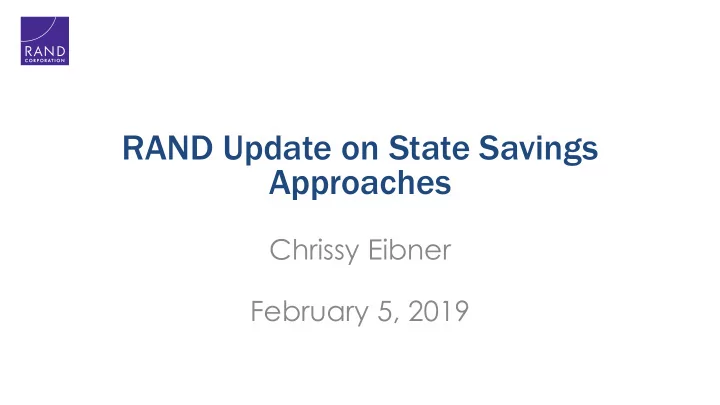

RAND Update on State Savings Approaches Chrissy Eibner February 5, 2019
RAND is working with CHCF to describe health care savings options for CA • Goal is to describe possible savings approaches and discuss their potential for the state of CA • Work is ongoing – Conducted environmental scan – Held discussions with stakeholders – Identified 17 options to consider – Literature review is underway • What have we learned do far regarding — – State-based drug cost reforms? – State all-payer claims databases?
Our work has identified several novel approaches to reduce pharmaceutical costs • OK recently implemented value-based contracting for select high-cost drugs (Aristada for schizophrenia, Melinta for skin infections) Contract guarantees that the drug will, on average, save money – If savings do not materialize, manufacturer state gets a rebate – • Louisiana “Netflix” model to pay for Hep -C drugs State pays monthly fee – Unlimited access to Hep-C drugs – Currently soliciting drug companies to participate – • Numerous states (including CA) have implemented or considered laws to improve pharma price transparency — a couple of states (OH, CT) have gone further in requiring transparency for PBMs • Price transparency for pharmaceuticals could be facilitated with APDCs
Sixteen states currently have APCDs, three (including CA) are implementing Source: APCD Council
A recent study found that NH APCD reduced imaging costs by 4-5 percent • New Hampshire APCD implemented in 2005 • Brown (2018) found that APCD implementation reduce consumer OOP spending on imaging by 5 percent ($7.9 million total savings), and payer spending by 4 percent ($36 million total savings) • Key caveats – Mehotra et al. (2014) found that only 1 percent of consumers use price transparency tools – Imaging is one of the most “shoppable” services – Unlike some price transparency tools, NH’s website took into account patient cost sharing
Challenges for APCDs • Packaging information so that is it meaningful – Building user-friendly tools--CA is currently working on this – Bundling services – Developing labeling and searching conventions • Tailoring information for stakeholders with different needs – Consumers – Payers and employers – Providers – Policymakers • Addressing missing data Self-insured employers – – Other exemptions and exceptions (e.g. small insurers) • Ensuring reliability and completeness – Missing data, erroneous submissions, duplicate submissions, etc.
APCDs have many uses beyond consumer price transparency • Identifying use of low-value care – MN report (2017) found that payers spent almost $55 million on low-value services in one year • Estimating how policy changes affect spending – Saloner and Barry (2017) used KS APCD data to analyze the effect of state autism insurance mandate on spending • Looking for utilization or coverage patterns that predict higher spending – Figueroa et al. (2017) used MA 2017 to identify characteristics of high spenders – RAND has ongoing work to estimate the relationship between transitions in coverage and spending changes • Allowing payers and employers to compare their negotiated rates to average payment
APCD-related initiative at RAND found that self-insured employers in Indiana pay 2 to 3 times as much as Medicare 750 Actual payments Payments ($ millions) 600 Simulated Medicare payments 450 300 150 0 Inpatient + Outpatient Inpatient Outpatient (Ratio=2.72) (Ratio=2.17) (Ratio=3.58) White, Chapin. 2017. Hospital Prices in Indiana: Findings from an Employer-Led Transparency Initiative . RAND, RR-2106-RWJ.
Next steps for RAND-CHCF project • Conduct more rigorous literature for each of the options identified, including Rx reforms and options to increase price transparency • Contextualize for California – Is this likely to be a big saver for CA? Why or why not? – Are there potential unintended consequences? • Report will likely be released sometime this coming summer
Recommend
More recommend